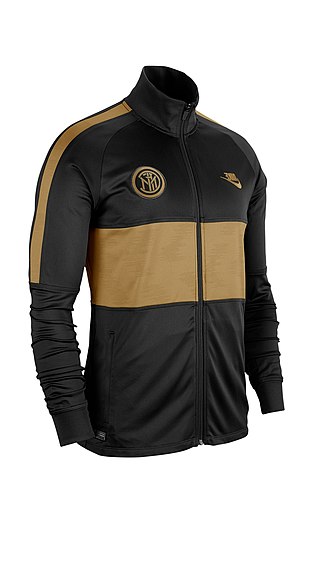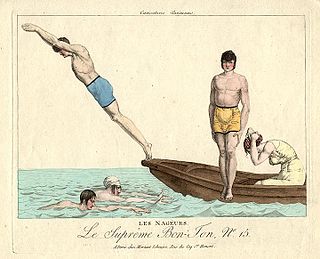
A swimsuit is an item of clothing designed to be worn by people engaging in a water-based activity or water sports, such as swimming, diving and surfing, or sun-orientated activities, such as sun bathing. Different types may be worn by men, women, and children. A swimsuit can be described by various names, some of which are used only in particular locations or for particular types of suit, including swimwear, bathing suit, bathing attire, swimming costume, bathing costume, swimming suit, swimmers, swimming togs, bathers, cossie, or swimming trunks, besides others.
Speedo International Limited is an Australian-British distributor of swimwear and swim-related accessories based in Nottingham, England, known for its swim briefs. The company has roots in Australia but is not based there anymore. Founded in Sydney in 1914 by Alexander MacRae, a Scottish emigrant, the industry-leading company is now a subsidiary of the British Pentland Group. Today, the Speedo brand can be found on products ranging from swimsuits and goggles to wristwatches. The Speedo brand was previously manufactured for and marketed in North America as Speedo USA by PVH, under an exclusive perpetual licence, which had acquired prior licensee Warnaco Group in 2013. As of January 2020, the Pentland Group purchased back the rights from PVH for $170 million in cash, subject to regulatory approval.

A one-piece swimsuit most commonly refers to swimwear worn primarily by women and girls when swimming in the sea or in a swimming pool, playing water polo, or for any activity in the sun, such as sun bathing. Today, the one-piece swimsuit is usually a skin-tight garment that covers the torso, although some designs expose the back or upper chest.

Everlast is an American brand of sports equipment, focused on boxing, mixed martial arts and physical fitness, which markets its products worldwide. The company was founded in The Bronx and is currently based in Manhattan. In 2007, Everlast was acquired by the British retailing group Frasers Group.

Hypercolor was a line of clothing, mainly T-shirts and shorts, that changed color with heat.

Competitive swimwear refers to the swimsuit, clothing, equipment, and accessories used in the aquatic sports of swimming, diving, synchronized swimming, triathlon, and water polo.

Arena S.p.A. is an Italian-French manufacturing company of competitive swimwear created in 1973 by Horst Dassler. The company is currently headquartered in Tolentino, Italy. In 1990, Arena was sold by Adidas to Japanese corporation Descente Ltd., which still commercialises its products.
High-technology swimwear, or tech suits, are scientifically advanced materials used for swimwear in competitive water sports such as swimming and triathlon. Materials of this type are normally spandex and nylon composite fabrics with features to reduce drag against the water. The fabrics include features that increase the swimmer's glide through water and reduce the absorption of water by the suit as opposed to regular swimsuits. Additionally, the suits are extremely tight, which make the swimmers body more streamlined and help reduce the buildup of lactic acid in the body.

A tracksuit is an article of clothing consisting of two parts: trousers and a jacket usually with front zipper. It was originally intended for use in sports, mainly for athletes to wear over competition clothing and to take off before competition. In modern times, it has become commonly worn in other contexts. The tracksuit was one of the earliest uses of synthetic fibers in sportswear.
Catalina is a brand of women's swimwear. It was once one of the oldest clothing manufacturers in California. Their history began in 1907, as Bentz Knitting Mills, a small manufacturer of underwear and sweaters. The name was changed to Pacific Knitting Mills in 1912, accompanied by the introduction of swimwear to their existing knit lines. The name was changed again finally to Catalina in 1928.

PVH Corp., formerly known as the Phillips-Van Heusen Corporation, is an American clothing company which owns brands such as Tommy Hilfiger, Calvin Klein, Warner's, Olga and True & Co. The company also licenses brands such as Kenneth Cole New York and Michael Kors. PVH is partly named after Dutch immigrant John Manning van Heusen, who in 1910 invented a new process that fused cloth on a curve.

A burkini is a style of swimsuit for women. The suit covers the whole body except the face, the hands, and the feet, while being light enough for swimming. This type of swimwear was designed with the intention of creating swimwear for Muslims who observe hijab in this way. The amount of skin covered is about the same as the person wearing a wetsuit and a swimming cap.
Jantzen is a brand of swimwear that was established in 1916 and first appeared in the city of Portland, Oregon, United States. The brand name later replaced the name of the parent company that manufactured the branded products. The brand featured a logo image of a young woman, dressed in a red one-piece swimsuit and bathing hat, assuming a diving posture with outstretched arms and an arched back. Known as the Jantzen "Diving Girl", the image in various forms became famous throughout the world during the early twentieth century.

The LZR Racer is a line of competition swimsuits manufactured by Speedo using a high-technology swimwear fabric composed of woven elastane-nylon and polyurethane. The swimsuits are made in body-length; they compress the body and trap air for buoyancy. The LZR Pro and LZR Elite were launched on 13 February 2008; the higher-priced LZR Elite was replaced by the LZR Elite 2 in early 2014. The LZR X was launched in early 2015. The technology is patented in Italy, and protected worldwide.

A swim brief or racing brief is any briefs-style male swimsuit such as those worn in competitive swimming, diving and water polo. The popularity of the Australian Speedo brand racing brief has led to the use of its name in many countries around the world to refer to any racing brief, regardless of the maker. Occasionally, the speedo genericized trademark is applied to square cut swimsuits, but in general the generic term is used in reference to swimming briefs. Swim briefs are also referred to as competition briefs, swimming trunks, bathers, togs, racer bathers, posing briefs, racing briefs, and colloquially in Australia, New Zealand, and the United Kingdom as budgie smugglers.

Many stylistic variations of the bikini have been created. A regular bikini is a two-piece swimsuit that together covers the wearer's crotch, buttocks, and breasts. Some bikini designs cover larger portions of the wearer's body while other designs provide minimal coverage. Topless variants are still sometimes considered bikinis, although they are technically not a two-piece swimsuit.

Russell Athletic is an American clothing manufacturer based in Bowling Green, Kentucky. Currently a subsidiary of global company Fruit of the Loom, Russell Athletic was the main brand of Russell Brands, LLC. until its acquisition in 2006.

The history of competitive swimwear has been dominated by concerns over public nudity in the first half of the 20th century and by efforts to reduce water drag in the second half. Those efforts initially led swimmers to reduce the early sagging one-piece swimsuits down to briefs only. With the development of new materials that tightly fit the body and offered lower resistance to water than human skin, this trend was reversed to a complete body coverage from heels to neck and wrists. FINA banned full-body suits from competition effective from 1 January 2010, stating that it "wishes to recall the main and core principle is that swimming is a sport essentially based on the physical performance of the athlete".

The history of swimwear traces the changes in the styles of men's and women's swimwear over time and between cultures, and touches on the social, religious and legal attitudes to swimming and swimwear.
Cole of California is a swimwear brand, known for innovations in fashionable swimwear.















